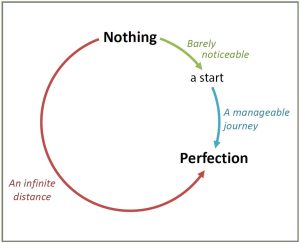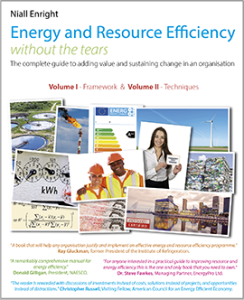 I started my book on energy and resource efficiency (available free as a pdf) with a traditional saying:
I started my book on energy and resource efficiency (available free as a pdf) with a traditional saying:
“How do you eat an elephant? Why, one bite at a time, of course”.
In the section on availability barriers to resource efficiency, I argued that we can drive a successful efficiency programme by getting a lot of people to regularly dedicate a little time rather than by getting a few people to commit a lot of time. Clearly, we need to start with where people are at and it is often unrealistic to ask someone to make a large change in their behaviour from the outset. Indeed, asking for too much or holding back for “perfection” are the root causes of many programme failures I have observed with my own eyes. So starting small is a reasonable strategy.
Is that true, though? Some argue that if all that we request in terms of change is a minor action, then this will result in – surprise, surprise – a small result! Folks like Donella Meadows, Bob Doppelt and many others have reasoned eloquently that no less than a fundamental change to our underlying systems will deliver the scale of change needed to address the magnitude of the problems we face. Similarly, Cambridge Professor David MacKay, in his fantastic book Sustainable Energy — without the hot air asserts:
“Modern phone chargers, when left plugged in with no phone attached, use about half a watt. In our preferred units, this is a power consumption of about 0.01 kWh per day. For anyone whose consumption stack is over 100 kWh per day, the BBC’s advice, always unplug the phone charger, could potentially reduce their energy consumption by one hundredth of one percent (if only they would do it).
Every little helps!
I don’t think so. Obsessively switching off the phone charger is like bailing the Titanic with a teaspoon. Do switch it off, but please be aware how tiny a gesture it is. Let me put it this way: All the energy saved in switching off your charger for one day is used up in one second of car driving. The energy saved in switching off the charger for one year is equal to the energy in a single hot bath.”
Wow! Therein lies the issue with these small actions, that is that they make us think that we have done our bit, that we have made our contribution to solving the problem. In short, they enable us to rest on our laurels.
Central to the debate over small actions is the notion of spillover. That is whether these small actions will lead to others in a “virtuous escalator” (positive spillover) or whether people will declare victory and cease to take an interest in further actions (negative spillover).
Tom Crompton and John Thørgersen have written a strong critique of the notion of spillover in their paper Simple and painless? produced for WWF. Their argument, which I have much sympathy with, is that many organizations, individuals and policymakers are in denial of the scale of change needed to fix environmental challenges and that promoting marginal improvements simply will not deliver change at a sufficient scale. A consumer who installs an LED lamp will not go on to install solar PV (although installing solar PV would most likely encourage the adoption of more LEDs).
We have already seen some examples of organizations which are making ambitious commitments to change from the outset, for example, Interface’s Mission Zero. This is the ideal.
However, we need to be realistic. Where we don’t have a strong mandate, we need to recognize that our request to staff in our organization is in competition with other demands on their time. We may well have simply no choice but to start small. It is better to do something than to do nothing, because, if we design our initial engagement carefully we can ensure that it grows over time [that’s the big caveat].
Where we don’t have a strong mandate, motivation to act will most likely be low, so we need to focus on capability – we need to make the initial action easy to accomplish. Critically, though, we need to consciously design the initial action so that it will lead to further action.
The initial action might simply be to observe or passively participate in an activity carried out by someone else. We know that when householders were asked to peer into their attics to observe the lack of insulation or to feel for themselves the heat loss from a water tank, they are more motivated to take action[1] themselves. Or we may start with an activity that creates a psychological connection with the change we want to achieve (expand box below for more on this).
Click here to learn more
The classic case study [1] of these techniques is that of the Canadian Cancer Society, which found that people who had agreed to wear a lapel badge with their logo were subsequently twice as likely to donate than those who hadn’t been asked to wear the badge.
One explanation for this behaviour dates back to the 1970s where Daryl Bem developed self-perception theory.[2]
As a result of the action of putting on the badge, the theory proposes our own self-view is modified. Now we see ourselves as supporters of the Canadian Cancer Society, and so subsequent actions that we take strive to maintain consistency with this self-image. Thus, when asked to make a donation we are much more likely to do so.
We may put together a series of interactions that lead to an increased probability of participation. For example, if we are looking to promote recycling we might prime the process by carrying out a survey of our staff to ask them if they think that providing more facilities for recycling would be a positive step (most would agree with this proposition). We could then follow up with a descriptive norm: “75% of the team in our department agree that recycling is a good idea.” At this point, we should be in a position to launch the change, with a much greater probability of commitment by staff.
We must avoid processes where folks can select actions involving minimum effort, which may have small results or, worse, let them conclude that the task is complete. Resource efficiency, we must establish from the outset, is about continual improvement. There is always another next step (or bite!).
[1] McKenzie-Mohr, Doug. Fostering sustainable behavior: An introduction to community-based social marketing (New society publishers, 2013) [2] Bem, Daryl J. Self-perception theory (1973)



0 Comments